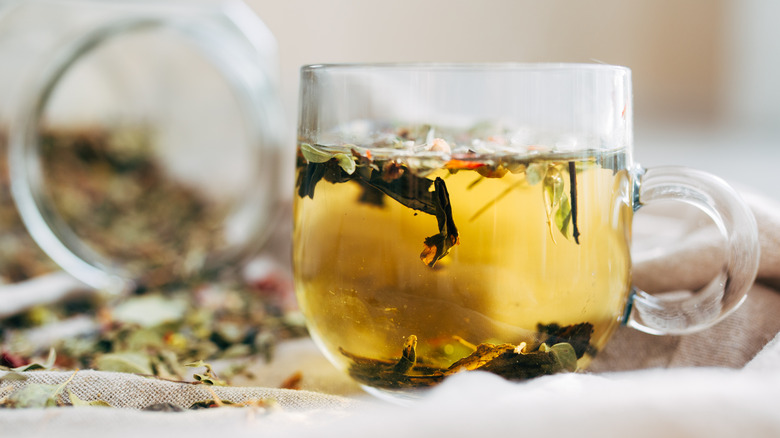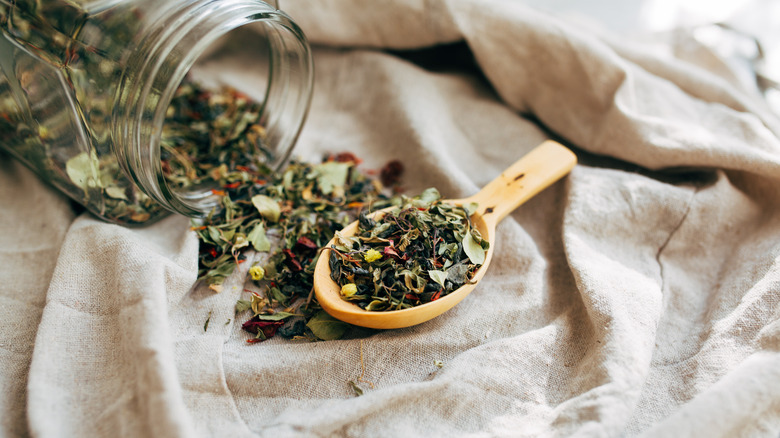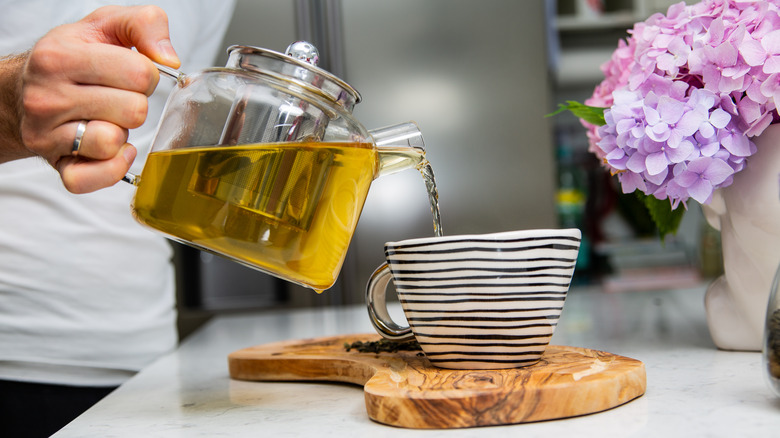What Does A Tea's Grade Actually Mean?
Few, if any, gastronomic delights have enjoyed such a faithful and enthusiastic fanbase as tea. Folks around the world have been drinking it since 2700 B.C.E., but to fans, it's more than just a beverage. As Ancient Chinese poet Lu Yu put it, "Tea tempers the spirits and harmonizes the mind, dispels lassitude and relieves fatigue, awakens thought and prevents drowsiness, lightens or refreshes the body, and clears the perceptive faculties." In 2020, tea drinkers worldwide downed 6.3 billion kilograms of the stuff — a figure data-analytics platform Statista anticipates will increase to 7.4 billion by 2025. You can even cook with tea. But, when you reach for your favorite tea brands, do you really know what's inside those little mesh bags?
Below the words "Earl Grey" or "Chamomile" on your tea's packaging, you're likely to spy a "grade." As you might guess, tea grading is a method of assessing and designating the quality of a certain batch of leaves. In American and European markets, grading refers to the size and type of tea, although larger leaves are not always indicative of a higher quality. So, how does the tea grading system work? And what does it mean?
It's all about size, buds, and strength
The two main black tea classifications you're likely to find on grocery store shelves are "OP" and "FOP." As a rule, the more leaves and buds a tea has when picked, the higher its grade. Orange Pekoe (OP) teas have tightly rolled leaves and no tip or buds. The next tier up, Flowering Orange Pekoe (FOP), is a physically longer tea leaf than OP and also has some buds. There's even a grade called Finest Tippy Golden Flowery Orange Pekoe (FTGFOP), which refers to super-high-quality FOP leaves with lots of golden tips. "Tip" refers to the number of flowering buds on the tea plant.
Why do these criteria matter? Size and "wholeness" (the durability of the leaves to resist breakage) heavily influence the flavor, clarity, and brewing time of a given tea. To assess size and wholeness, manufacturers shake tea leaves through different mesh screens and see how small of a screen they can pass through, and how many the leaves break on the way down. It's here that other sub-classifications of Orange Pekoe et. al. enter the scene.
"Dust" Orange Pekoe tea leaves are very small broken tea particles, and slightly larger than that are "Fannings." Fanning- and Dust-graded tea might seem like poorer quality, but they typically have shorter brewing times and impart a strong flavor. Similarly, "Broken" grade tea leaves are intentionally made smaller by machines in order to help give the tea a stronger flavor by creating more surface area.
Different countries use different grading systems
Understanding your tea's grade lends a deeper appreciation, connection, and depth of enjoyment with your steaming cupful. But, to truly know your cup, consider where in the world it came from.
The Pekoe system only grades black tea. Green teas have no formal grading system in the Orange Pekoe classification. In the Chinese Tea Grading System, however, green tea is given a very complex grading system, with each individual type of green tea having its own idiosyncratic classifications. Taiwan grades its tea on flavor and aroma; Korea grades on plant maturity at the time of harvest; Japan grades on color and brightness. There is no international standardization for tea grading, so your tea could differ pretty significantly depending on where in the world you get it. Still, the Orange Pekoe system was created in the U.K., and it is the most commonly adopted tea grading system in the world today. As such, when you're visiting a regular grocery store in the U.S. or most parts of Europe, you can be pretty certain that Pekoe grading was used to classify your tea.


